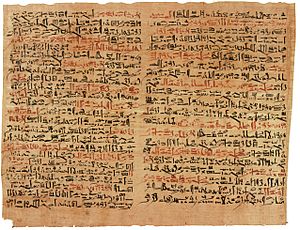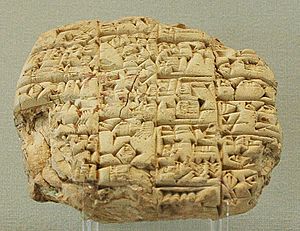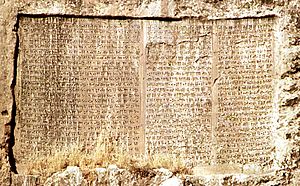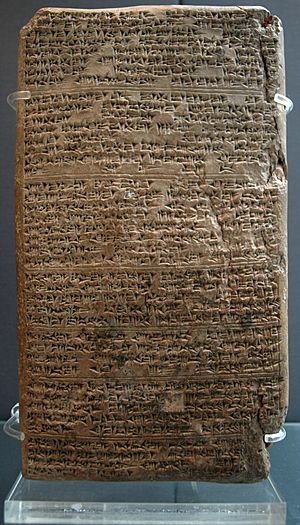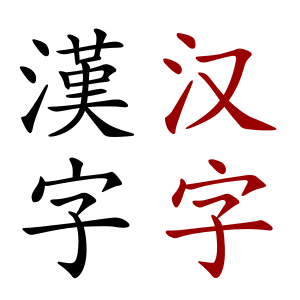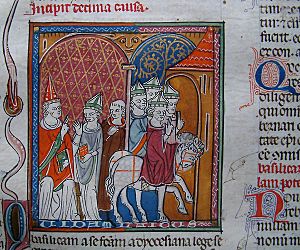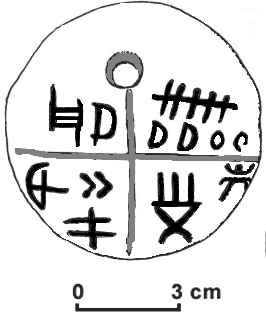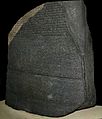Writing facts for kids

Writing is how we record language using symbols. These symbols must be known to others so they can read what is written. Writing often includes pictures or decorations, which help explain the message. Most educated people in a country use the same writing system for their language. Being able to read and write is called being literate.
Writing is different from speech because readers don't need to be there when the writing is made. We can read texts from long ago or from different parts of the world. Writing helps us store and share knowledge. It is one of the most important inventions ever. Writing began after people started living in towns and farming became common. The first writing appeared around 3,300 BC, over 5,000 years ago, in the Middle East.
Today, we usually write on paper. But we can print on almost any surface. Televisions, movie screens, and computers can also show writing. Many materials were used for writing before paper was invented. These include clay, papyrus, wood, slate, and parchment (animal skins). The Romans used waxed tablets with a pointed stylus for quick notes. The invention of paper by the Chinese was a big step forward.
People traditionally write with a hand tool like a pencil, a pen, or a brush. But more and more, writing is done by typing on a computer keyboard.
Contents
What is Writing?
Writing is a system of symbols that can share any and all thoughts. This means a full writing system can show anything that can be said out loud. A key step in writing was the invention of the rebus, where a picture stands for a sound, not just an object.
We can only be sure a symbol system is full writing if we can translate it into a modern language. For some very old scripts, we cannot do this.
History of Writing Systems
Writing was invented several times in different places. The writing systems of Sumer, ancient Egypt, China, and the Maya were all invented separately. All these early systems started with pictographs, which were pictures that stood for things. Over time, they developed into more complex systems. Our own alphabetic system is different because it is based on the sounds of spoken language. All alphabets today come from the first one, which began with the Phoenicians and the Ancient Greeks.
Sumerian Cuneiform
The Sumerians lived in Mesopotamia, a fertile area between the Tigris and Euphrates rivers, mostly in what is now Iraq. Around 5,000 years ago, they created a writing style called cuneiform. They used pointed tools to press triangular marks into soft clay tablets. After the clay dried in the sun, the tablets could be moved and read by others. We know that cuneiform was first used for trade, keeping records, and managing things.
The first signs were mostly pictures. But soon, they became symbols for objects, ideas, and sounds. This writing system was very successful and lasted longer than the Sumerian empire itself. Other civilizations in the Middle East, like the Akkadians, Babylonians, and Assyrians, also used it. The last known cuneiform writing was from AD 75, meaning the system lasted for over 3,000 years. Each version of cuneiform had to be figured out separately because the languages were different. Clues came from documents written in more than one language.
Ancient Egyptian Hieroglyphs
This is one of the most famous ancient writing styles. It was invented around the same time as cuneiform but looked very different and used different materials. Egyptians actually had three writing systems for the same language:
- Hieroglyphic: The well-known picture writing found on stone monuments.
- Hieratic: A faster, flowing script used by priests.
- Demotic: A flowing script used by everyday people.
The tools used for writing changed depending on the material. The two flowing scripts were written with reed pens and carbon inks on papyrus. If they wrote on cloth, they used a brush. Many examples still exist today. Hieroglyphs were carved into stone or painted on stone surfaces. Many of these carvings survive, some still with their original colors.
A very important discovery for understanding hieroglyphic writing was the Rosetta Stone. This is a granite slab with the same message written in hieroglyphic, demotic, and Greek. Since ancient Greek is well understood, it helped experts figure out the other two scripts.
Chinese Characters
Chinese is the language with the most native speakers in the world. Its writing history goes back to about 1400 BC. The Chinese writing system is a mix of methods. Characters can have one or more of these parts:
- Pictographic: They look like the objects they represent.
- Visual logic: For example, the number '3' is shown with three horizontal lines.
- Complex logic: The character for the sun is a box with a line in the middle.
- Rebus: A character is used for a word that sounds similar to what the character originally meant. For example, the character for wheat is also used for 'come' because the words sound alike.
- Semantic-phonetic: A combination of a character for meaning and another for sound.
Chinese has a huge number of characters, around 50,000. Because of this, printing methods were never as easy in China, even though they invented printing early. In the 14th century, a man named Wang Tzhen had 60,000 wood blocks cut for printing. This was a huge amount of work and money. Even with printing machines from Europe later on, the large number of characters made printing very slow.
China has eight main regional languages that are hard for speakers of one to understand another. Many true dialects also exist. The writing system works mainly because about 70% of people speak Mandarin. Learning to read and write Chinese is very difficult, which can slow down efforts to increase literacy. There have been attempts to make the system simpler. One big effort was Pinyin, which aimed to replace Chinese characters with an alphabet system.
The Alphabet
It seems that the idea of an alphabet – a writing system based entirely on sounds – was invented only once. Then, it was copied and changed to fit many different languages. Even though no alphabet perfectly matches its language, it is flexible enough to work for almost any language. It was a truly unique invention.
Our alphabet is called the Roman alphabet. Other alphabets include the Cyrillic alphabet. All these alphabets come from the ancient Greek alphabet, which appeared between 1100 and 800 BC. The Greek alphabet probably developed from the Phoenician script, which came a bit earlier and had some similar letter shapes.
The Phoenician language was a Semitic language. This group of languages includes Arabic, Maltese, Hebrew, and Aramaic (the language Jesus spoke). We don't know exactly how the idea of an alphabet came about. But the Phoenicians, who were traders, created letters that the early Greeks adapted to make their alphabet. One big difference is that the Phoenician script had no pure vowel sounds. Arabic script has vowels that can be shown with diacritics (small marks above or below the line).
No ancient script, whether alphabetic or not, had pure vowels before the Greeks. The Greek alphabet even has two vowels for 'e' and two for 'o' to show the long and short sounds. This shows that a lot of thought went into both the Phoenician invention and the Greek changes. However, we don't have details about how either process happened.
Some researchers believe that Semitic scripts came from Proto-Sinaitic, an old script with only a few known writings. They think the original source of this script might have been the Egyptian hieratic script. By about 1900 BC, hieratic had added some alphabetic signs to show the consonant sounds of foreign names.
Scripts We Can't Read Yet
There are several ancient writing systems that experts have not been able to figure out, even after much effort. Two of the most famous are the script of the Indus Valley civilization and Etruscan. The Indus River civilization existed before other literate civilizations in India, dating back to about 2500 BC. Their cities, like Mohenjo-Daru and Harappa, were well-planned. Their script is found on seal stones, terracotta, bronze, bone, and ivory. All these writings are short, and the language itself is unknown.
The Etruscan language used Greek letter shapes. It is mostly found on Etruscan tombs in Italy. The Etruscans had an empire before the Romans, who later defeated them and adopted some of their ideas. All knowledge of their language was lost, except that some names on tomb memorials can be read using the Greek letters.
Vinča Symbols
The Tărtăria tablets are three clay tablets found in 1961 in Romania. These tablets, from around 5300 BC, have symbols carved into the clay. These are called "Vinča symbols." Some people think they are a very early, undeciphered language. If this is true, they would be the oldest known form of writing.
Similar symbols were found in 1908 in Vinča, a suburb of Belgrade in Serbia. Since 1875, over 150 Vinča sites have been found in Serbia alone. The culture of this entire area is called the Vinča culture. Even though some of these symbols look exactly like letters in Etruscan, Greek, and Aramaic, most experts believe they developed on their own.
Literacy for Everyone
It has only been in the last 150 years that most people in Europe and North America have been able to read and write. In many other parts of the world, this didn't happen until the 20th century. Before then, literacy was mainly for religious leaders or people trained as priests. Even rich people were often unable to read or write and used scribes to write for them.
The invention of printing came before most people learned to read. Before 1500, every book had to be copied by hand. This meant there were very few books compared to the billions we have today. Widespread literacy needed cheap books. Even now, many people around the world still cannot read or write.
Handwriting
Handwriting is the normal way of writing using a pen and paper. It can be for writing for yourself, like in a diary, but it mostly means sending letters. In the past, it was almost the only way for people far apart to communicate. Now, the telephone and e-mail are the most common ways to talk to people from a distance.
Related pages
Images for kids
-
The Rosetta Stone, with writing in three different scripts, helped us understand Ancient Egyptian.
-
How pictograms changed into abstract shapes in Mesopotamian cuneiforms, Egyptian hieroglyphs, and Chinese characters.
-
The Narmer Palette, showing two creatures that represent the joining of Upper and Lower Egypt, around 3100 BC.
-
A round clay envelope with accounting tokens inside, from the Uruk period, found in Susa. Now at the Louvre Museum.
See also
 In Spanish: Escritura para niños
In Spanish: Escritura para niños


